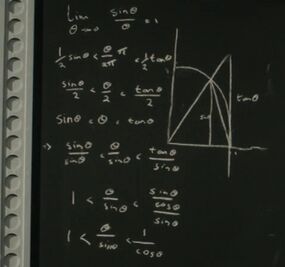1 (number)
- You may wish to consult
Onefor other, similarly-named pages.
1 (Roman numeral: I) (TV: The Man from MI.5 [+]Loading...["The Man from MI.5 (TV story)"], The Church on Ruby Road [+]Loading...["The Church on Ruby Road (TV story)"]) was a prime number. (AUDIO: The Haunting [+]Loading...["The Haunting (audio story)"])
According to the Tenth Doctor, "any number that reduce[d] to 1 when you [took] the sum of the square of its digits and continue[d] iterating it until it yield[ed] 1" was a happy number. (TV: 42 [+]Loading...["42 (TV story)"])

The Twelfth Doctor once proved that . (TV: The Pilot [+]Loading...["The Pilot (TV story)"])
Block Transfer Computation made use of 1s and 0s, as it was written in binary. (AUDIO: The Enchantress of Numbers [+]Loading...["The Enchantress of Numbers (audio story)"])
According to the Second Doctor, a one in 13 chance was about 7.6923 percent, odds he didn't like. (COMIC: Card Conundrum [+]Loading...["Card Conundrum (comic story)"])
The Fourth Doctor described Streets Doctor Who Ice Cream as "the first Doctor Who ice treat. (TV: Streets Doctor Who advertisement [+]Loading...["Streets Doctor Who advertisement (TV story)"])
The Tenth Doctor believed that Dalek Caan, who had emerged as the last of the Cult of Skaro, was the one remaining Dalek in "the whole universe". (TV: Evolution of the Daleks [+]Loading...["Evolution of the Daleks (TV story)"])
The Twelfth Doctor once told Bill that "eleven plus two" was an anagram of "twelve plus one", to which Bill responded that both of these were equal to 13. (COMIC: Harvest of the Daleks [+]Loading...["Harvest of the Daleks (comic story)"])
British Summertime began in early 2005 on a Sunday morning at 01:00am when the clocks went forwards. (PROSE: The Clocks Go Forward [+]Loading...["The Clocks Go Forward (short story)"])
The countdown towards the Ninth Doctor's eviction on Big Brother counted from 6 to 0, going through 5, 4, 3, 2, and 1. (TV: Bad Wolf [+]Loading...["Bad Wolf (TV story)"])

In an emergency transmission sent by the TARDIS, the Thirteenth Doctor listed 5 things that she did in any worrying situation. The first was remembering that she would get through the situation, and that darkness never prevailed. (WC: Message from the Doctor [+]Loading...["Message from the Doctor (webcast)"])
Champion - LEVEL 1 was a Zu-Zu-Poo card. (AUDIO: Maker's Wish: After Dark - Slalvok [+]Loading...["Maker's Wish: After Dark - Slalvok (audio story)"])
The Fourteenth Doctor's first trip on his favourite planet was during the Meep's attempted destruction of London. (PROSE: The Doctor's Busiest Day [+]Loading...{"page":"8","1":"The Doctor's Busiest Day (short story)"})
In the language spoken by the crew of the captain's spaceship that accidentally flew to the edge of the universe, the word for 1 was "Sensill". The Fourteenth Doctor, while not speaking the language was able to translate this number, and used that to read the ship's base code, data logs and control elements of the ship. (TV: Wild Blue Yonder [+]Loading...["Wild Blue Yonder (TV story)"]) Seeing "Jimbo", the Doctor discovered that the ship may not have been as abandoned as it first seemed. (PROSE: The Doctor's Busiest Day [+]Loading...{"page":"8","1":"The Doctor's Busiest Day (short story)"})
Ruby Sunday once recalled celebrating at Christmas at a club, at which time the dancefloor was packed, with one person in the middle of it all: the Fifteenth Doctor. (PROSE: Who's the Doctor? [+]Loading...{"page":"6","1":"Who's the Doctor? (short story)"})
Behind the scenes[[edit] | [edit source]]
Though AUDIO: The Haunting establishes that 1 is itself considered a prime number in the DWU, this is a point of contention among mathematicians. There was significant disagreement as to whether to classify 1 as a prime number in the story's time period of the 1890s. In particular, the entry for Number published in 1890 in the 9th edition of Encyclopædia Britannica stated that every positive number was either prime or composite, and explicitly listed 1 as prime.[1] Nowadays, in the 21st century, 1 is instead generally considered as neither prime nor composite. To further complicate real-world existence of 1 as a number, there have even been periods of time - like Ancient Greek era - where 1 was in fact not even considered a number.[2] This included notable mathematicians like Aristotle and Euclid.[3]
Though unremarked in PROSE: Daisy Chain, 1 is also the first and second Fibonacci number.
Footnotes[[edit] | [edit source]]
- ↑ A. Reddick et al. The History of the Primality of One---A Selection of Sources. Accessed at http://primes.utm.edu/notes/one.pdf on 7.12.2015.
- ↑ Speusippus of Athens: A Critical Study With a Collection of the Related Texts and Commentary, Leonardo Tarán, 1981 (pgs 34-38)
- ↑ "What is the smallest Prime?", Chris K. Caldwell & Yeng Xiong; published in Journal of Integer Sequences Vol. 15 (2012)

